The Rise of the West
I track the historical rise of West Europe by quantitatively analyzing the birth of notable people of science, and then I put it in context with other indicators of historical development. The data together show that West Europe had developmentally surpassed the rest of the world prior to 1500 A.D., before the establishment of overseas colonies or slavery. It is clear that the West’s rise to global prominence has deeper roots than often suspected.

In this post I document the rise of the West, starting with my own novel analysis of births of notable people of science. Afterwards I put this into context with other indicators of development, altogether capturing aspects of economic, technological, scientific/academic and social development. In summary, I will look at:
Notable people of science
Universities
Technology and construction
Urbanization
Book production
Literacy and numeracy
Violence
Economy
The Rise of Notable People
To track the rise of the West1, I will first consider births of notable people of science, a continuation of my prior work based on the database by Laouenan et al. (2022).2 The term “people of science” is used in a broad sense, including scientists, philosophers, mathematicians, engineers, explorers, and so on.
In the period between 1000 and 1500 A.D., the relevant major civilizations were West Europe, the Islamic world, India, and China. Below I have illustrated the notable people per-capita rates for countries accumulated over the 1000–1500 period. I have focused on the region containing Europe and the Middle East as, with respect to this measure, they are the only real competitors in this period.3
A major gulf has already appeared between Western Europe and the rest of the world prior to 1500 AD. No large-population countries outside West Europe produce notable people at very high rates (Armenia, a small country, is the best non-European performer in this period). On the other hand, all West European countries except Ireland produce notable people at least at moderately high rates, and most at very high rates between 1000 and 1500 AD.
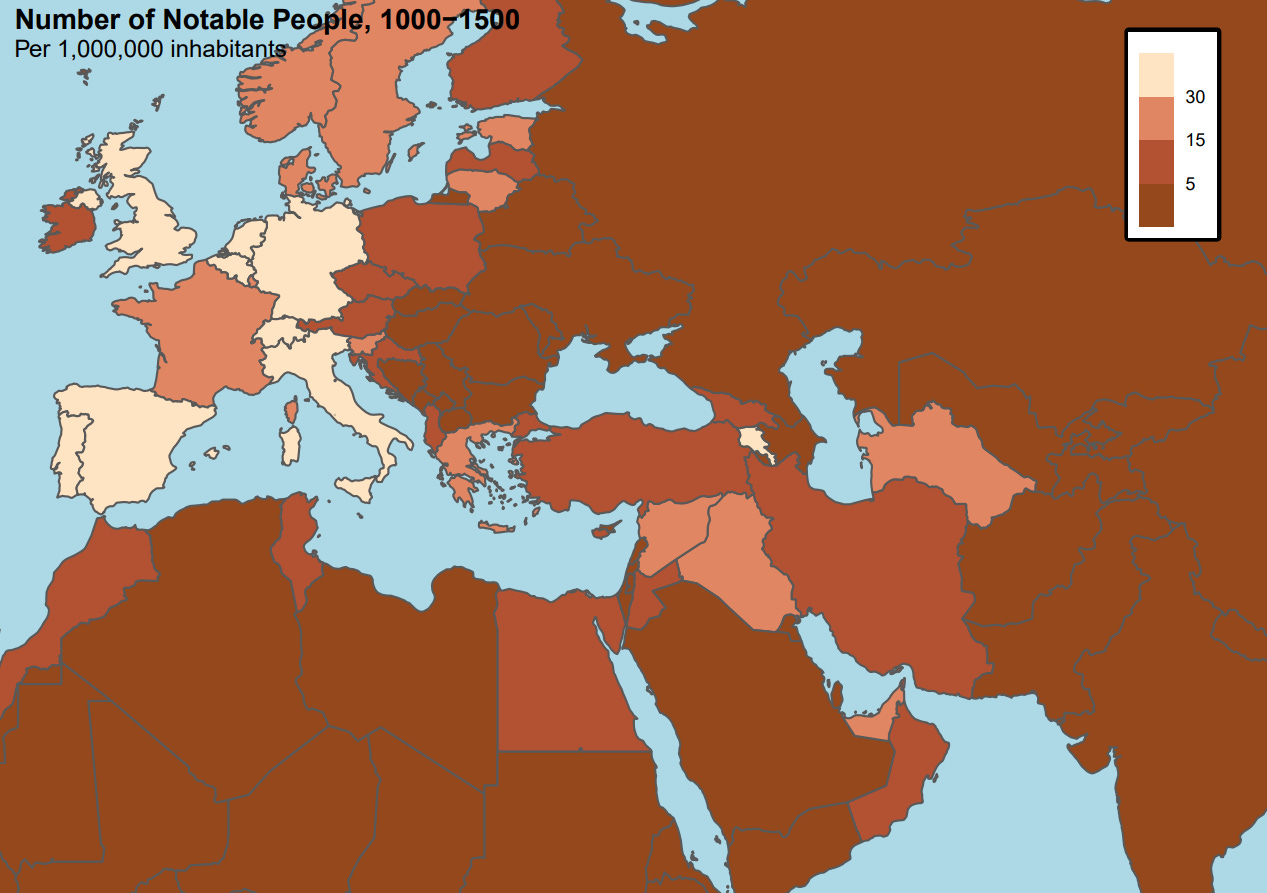
Let us look more closely when this gulf between the West and the rest emerges. I have calculated how many notable people of science per-capita are born at any given moment in time. I have taken the population-weighted average of the top four countries of the Islamic world and juxtaposed them with the average of some of the top of West-European countries. This is shown in the figure below, a stark illustration of the rise of the West. The inflection point — around 1300 AD — is followed by an enormous, unprecedented rise of notable people, truly marking the beginning of a new era.
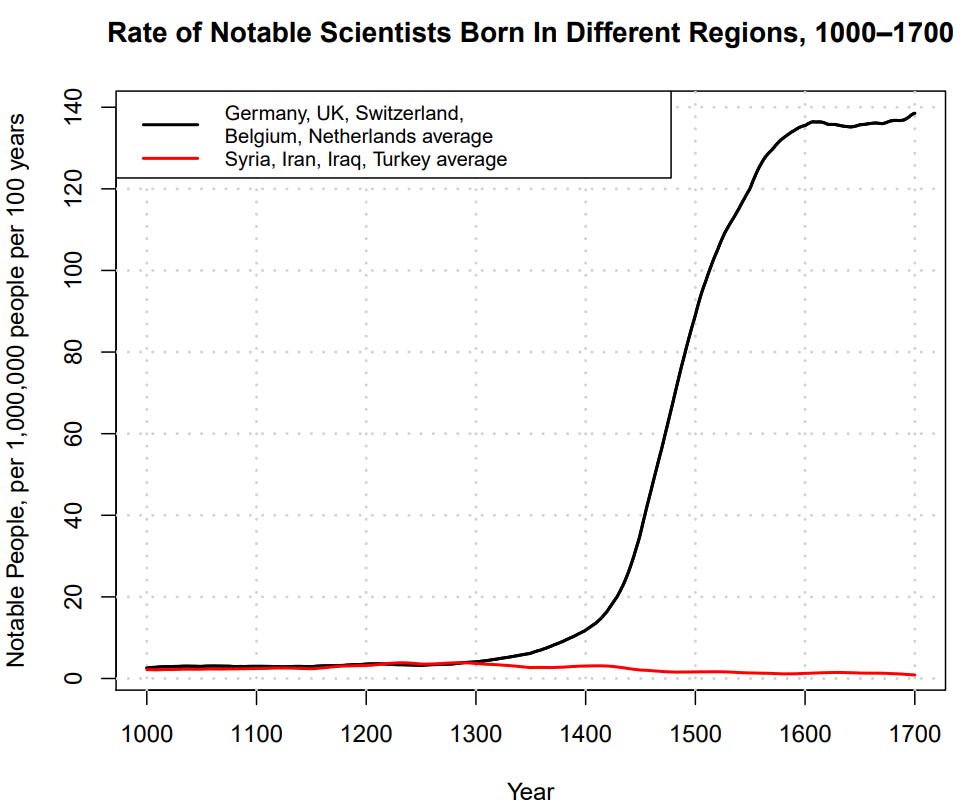
Between 1000 and 1300, neither civilization has any clear advantage, producing notable people of science at similar and relatively stable rates (and both regions higher than elsewhere).4 In the period before 1000 AD, the Islamic world even tends to outperform West Europe. But the Middle East reaches its zenith between 1200 and 1300 and begins a downward trend, marking the end of the “Islamic Golden Age.” Starting from 1300, West Europe instead heads in a sharp upwards trajectory. Before 1400, long before the colonization of mainland Africa or the Americas, West Europe produces notable scientists at a rate far higher than anywhere else in the world: a Great Divergence long before the great economic divergence.
To probe a bit into the country specifics, below I show the rates by individual select countries. Those which ascend early are Italy — obviously, being the face of the Renaissance — as well as Germany, Switzerland, and the Low Countries (Netherlands, Belgium, etc). The United Kingdom ascends later, but does so in great fashion. Scandinavia (not shown) also transitions in the later period (starting in the 1400s).
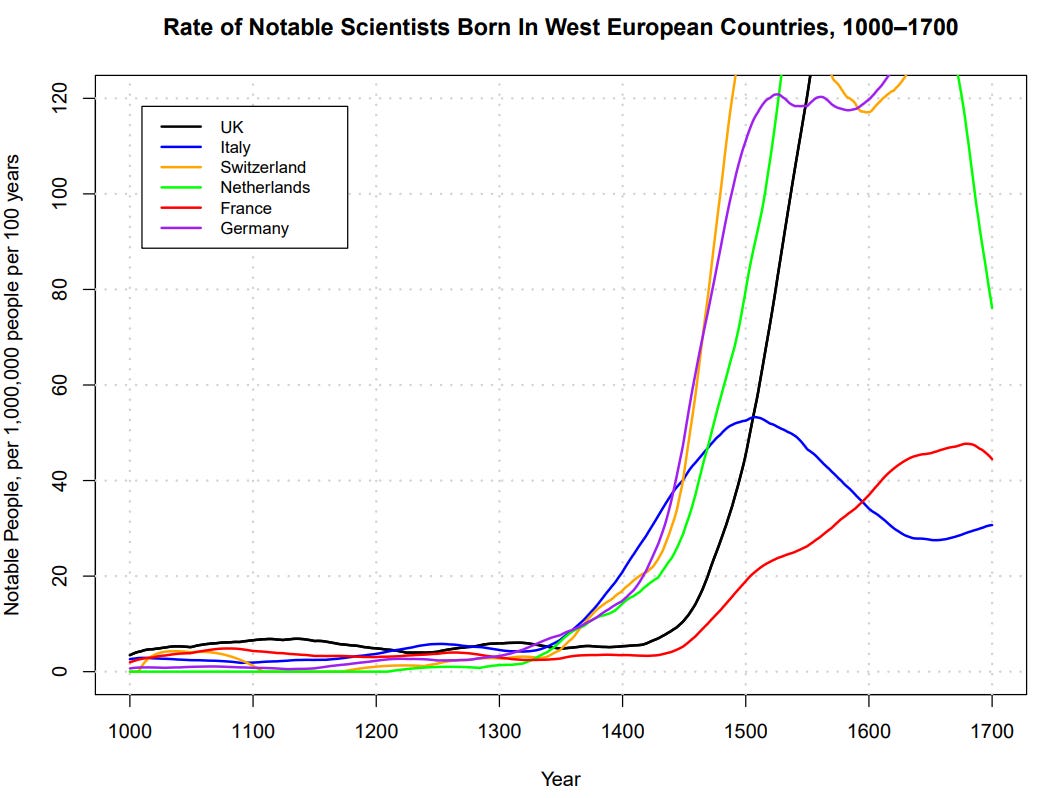
Beyond the onset of the divergence, the disparity between Europe and the rest of the world widens over time. Below the accumulated number of notable people per capita between 1300 and 1700 are shown. Europe has diverged greatly from the rest of the world.
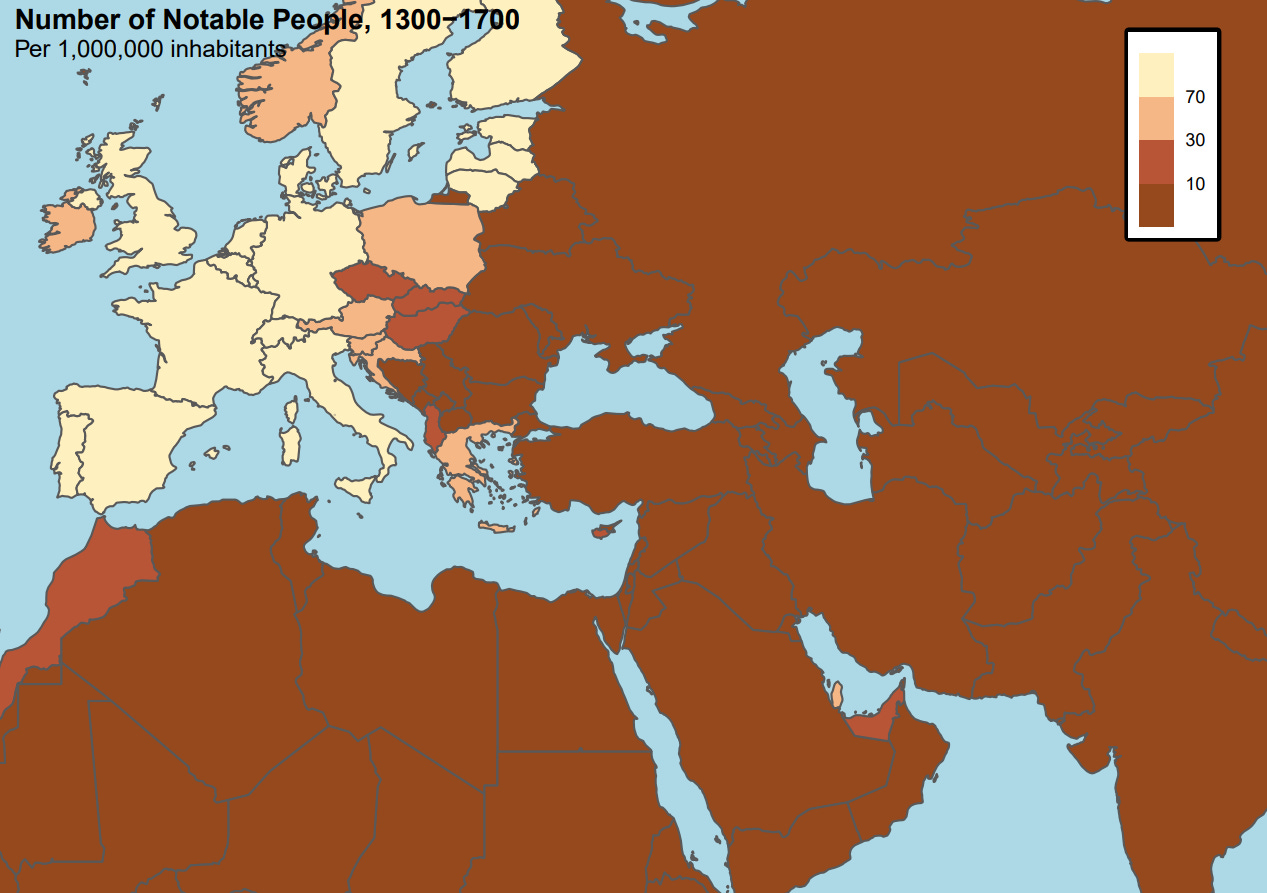
This concludes this brief summary of the rise of the West in terms of notable people of science. I will now put this in context with other indicators of development, and possibly proximate causes of the rise observed here. As we will see, many other important changes occurred between 1000 and 1500 AD.
Universities and education
In the Middle Ages, the university was arguably a uniquely European institution — the so-called studium generale. Certainly, the widespread establishment of universities is illustrative of the broader intellectual culture slowly penetrating Europe, and illustrative of the region's ongoing development.5
The first medieval university was established in Bologna, Italy, in 1088. Other earlier universities were established in Oxford in the United Kingdom and in Paris in France. By 1500, universities had been established widely across Europe.6
To look at the timeline more closely, below I have plotted the cumulative number of universities established throughout Europe between 1000 and 1500. While the earliest few are established before 1200, it is from the 1200s and forward that universities get established in great numbers. This is not long before the West European rise of notable people, the onset of which began around 1300 AD.
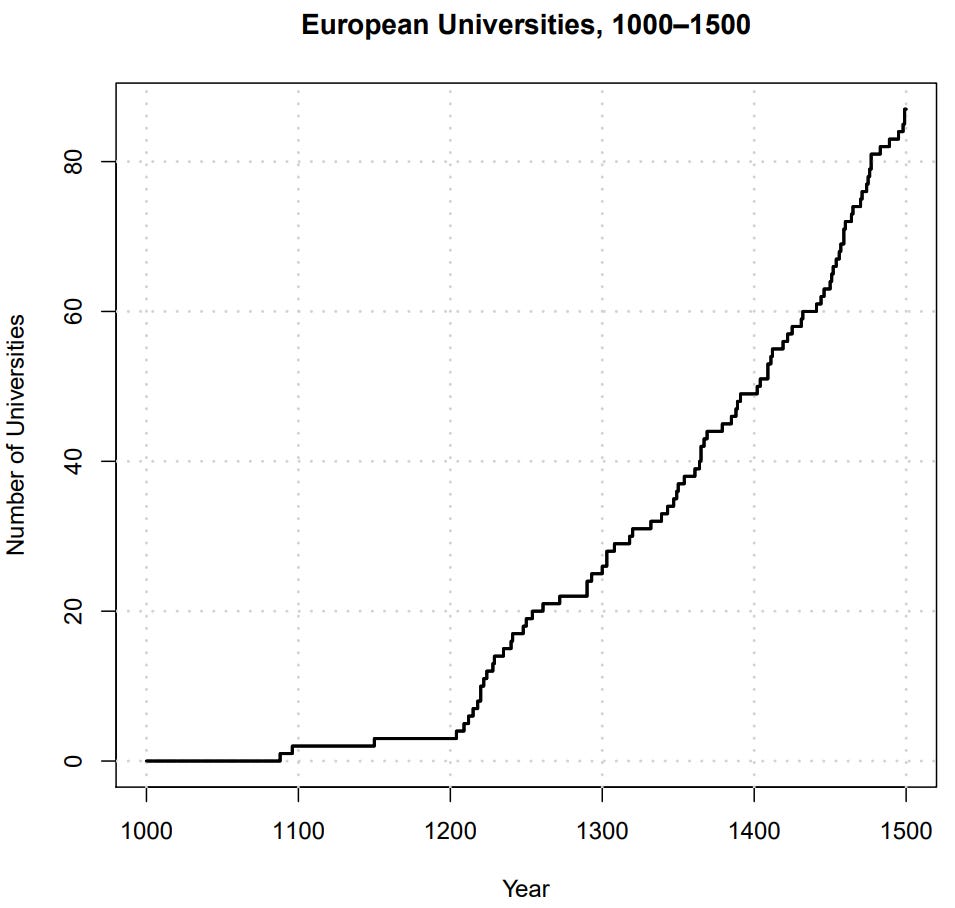
The geographical distribution of medieval universities together with their establishment period can be seen below. The underrepresentation of universities in East Europe is conspicuous. It is also evident that this development spread to the north somewhat later (e.g., Scandinavian universities in Uppsala, Sweden, 1477; Copenhagen, Denmark, 1479). The universities of the early period (prior to 1300) were established in Italy, France, Iberia, and England.
More generally, schooling increased at least since the 13th century as illustrated for England below. This increase was both in terms of the raw number of schools, but also in terms of schools per capita (Pleijt, 2020). The average time spent in education also rose (Pleijt, 2018).
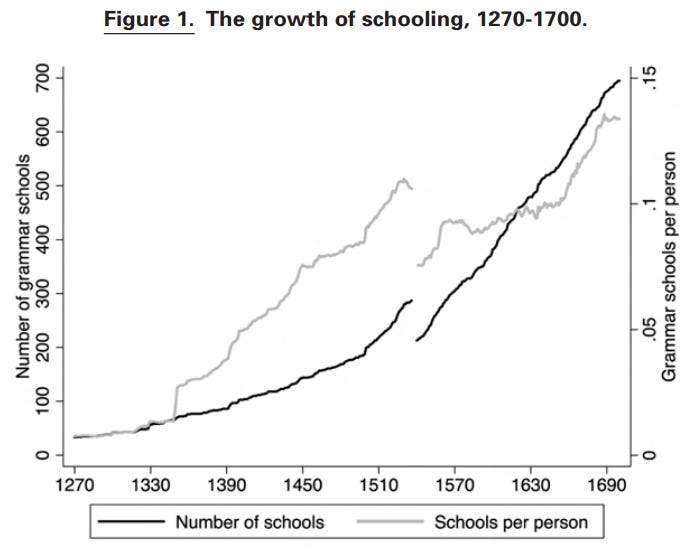
Technology and Constructions
Important technologies used during the Middle Ages include windmills, tidal power and watermills, clockwork, and ultimately the printing press. Improvements in ship technology and ship building, navigation tools, and cartography also aided exploration in the Age of Discovery.
The water mill is an old technology, being in widespread use already by the Roman Empire (Lucas, 2005). Water mills became widely adopted in medieval Europe, and in certain cases for new innovative applications. For example, the labor-intensive textile production was aided with water-powered fulling mills. This was the first step in the mechanization of textile production, which would later play an important role in the industrial revolution.
Adam Lucas (2005) identifies the first uses of various types of mills in medieval Europe, seen below. It illustrates the slow transition into partial mechanization in certain regions in Europe.
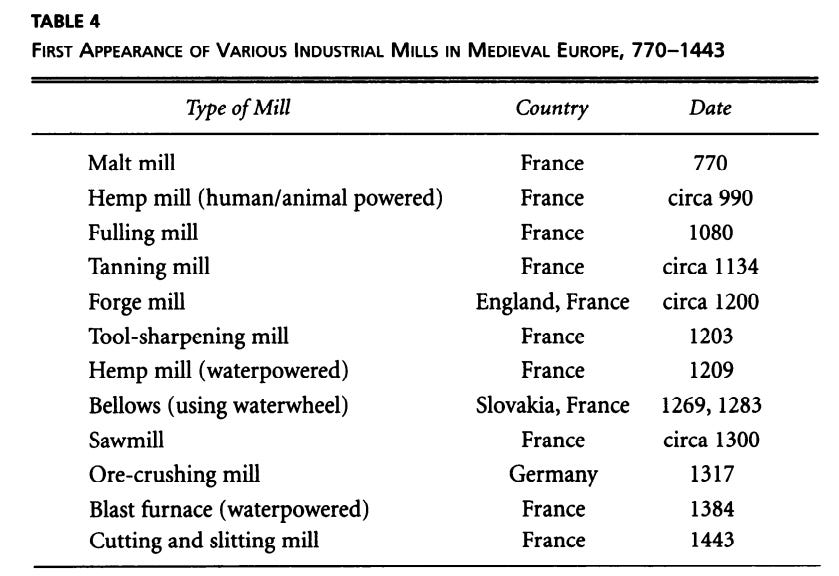
Windmills served various purposes, the most important being grinding grain for food. The windmill proliferated widely across medieval Europe, as illustrated below. The number of windmills perhaps numbered in the tens of thousands in Europe by the early fourteenth century. In England alone, an estimated 4,000 windmills had been built by 1300 (Langdon & Watts, 2005). In Braun & Hogenberg’s 16th century collection of city illustrations, the illustration of Copenhagen (from 1577-1578) includes 15 windmills.
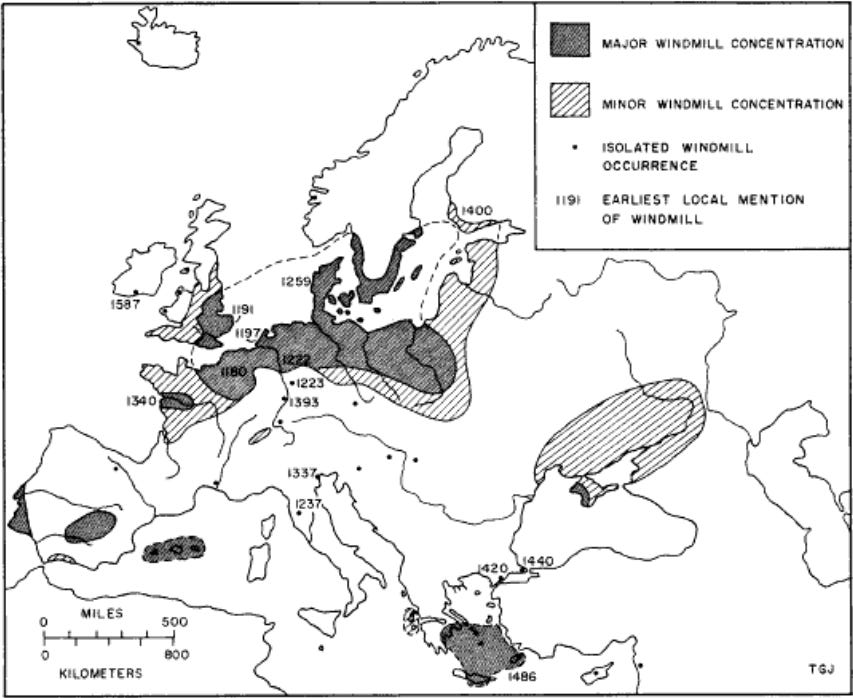
Another domain of technological advancement was that of seafaring, ultimately culminating in the Age of Discovery. The chart below illustrates how innovations made it possible for medieval ships to carry much more cargo. Navigation ability was also improved through various innovations.
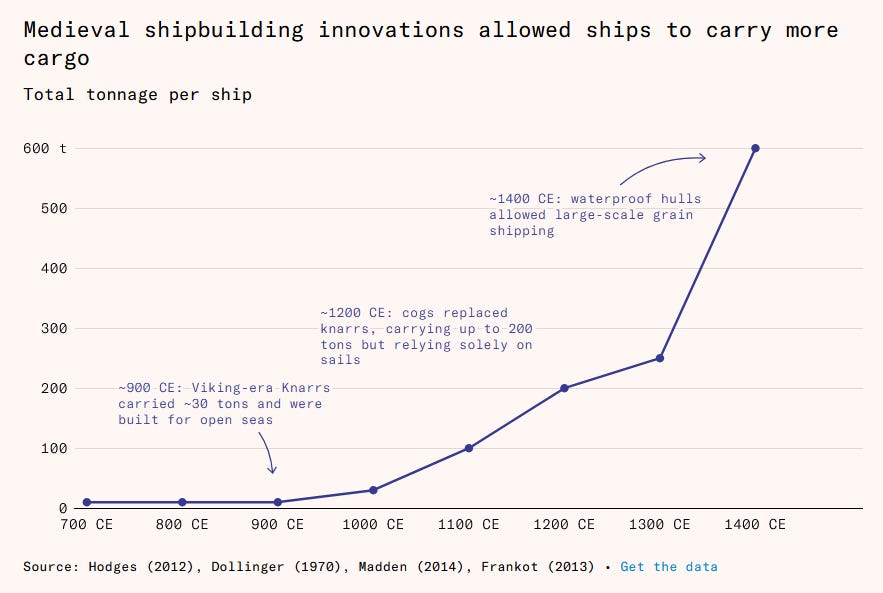
Medieval Europe is of course well-known for its impressive cathedrals and castles. For example, the Lincoln Cathedral, constructed 1185–1311, with its now-lost central spire reputedly being the world’s tallest construction of its time. But perhaps the best example of late medieval European construction is the cathedral of Florence, constructed 1296–1436. Admired not only for its artistic qualities, but, more importantly in this context, for its unprecedented engineering complexity. The mind behind the dome of the Florence cathedral, Filippo Brunelleschi, is often considered the first modern engineer, representing a major milestone in the history of technology. It remains the largest brick dome built to this day.
The figure below illustrates quantitatively how North Italy dominated in church-building activity in the earlier periods, but the Low Countries eventually came to dominate. This pattern — the early Italian advantage followed by a transition into a Low Countries advantage — is replicated for several other developmental indicators, not least in my own analysis of notable people of science.
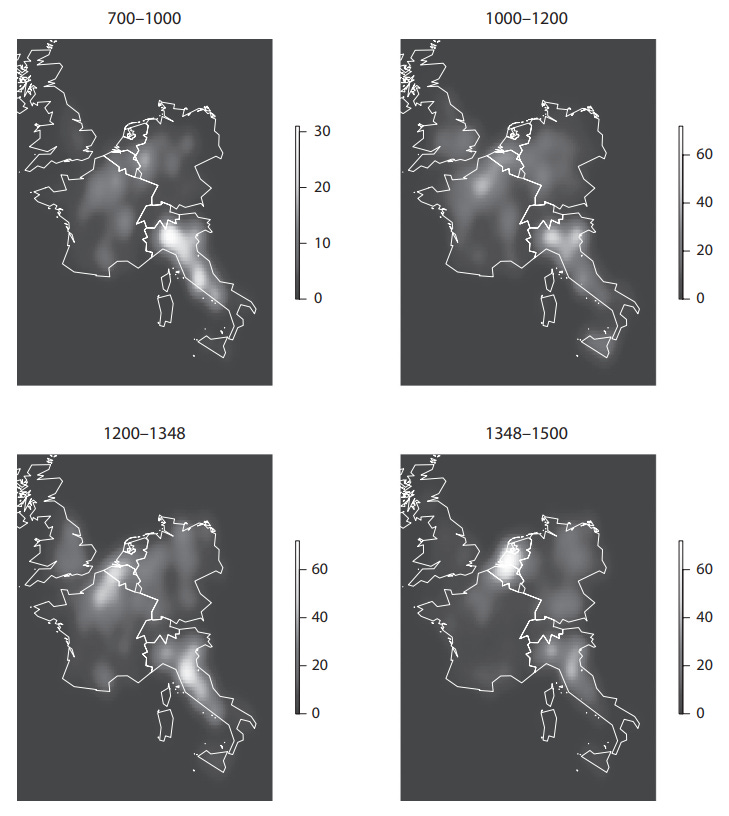
The two most important and complex technologies of the late medieval period are arguably Gutenberg’s moveable-type printing press and the public mechanical clock. Boerner et al. (2021) document the diffusion of these technologies throughout Europe, as can be seen below. Early adoption was most widespread in wealthier areas, such as the Low Countries, northern Italy and Germany. While Europe put these technologies to use, Gutenberg’s movable-type printing press was famously blocked by religious authorities in the Islamic world, arguably of great importance to the divergence between West Europe and the Islamic world.7
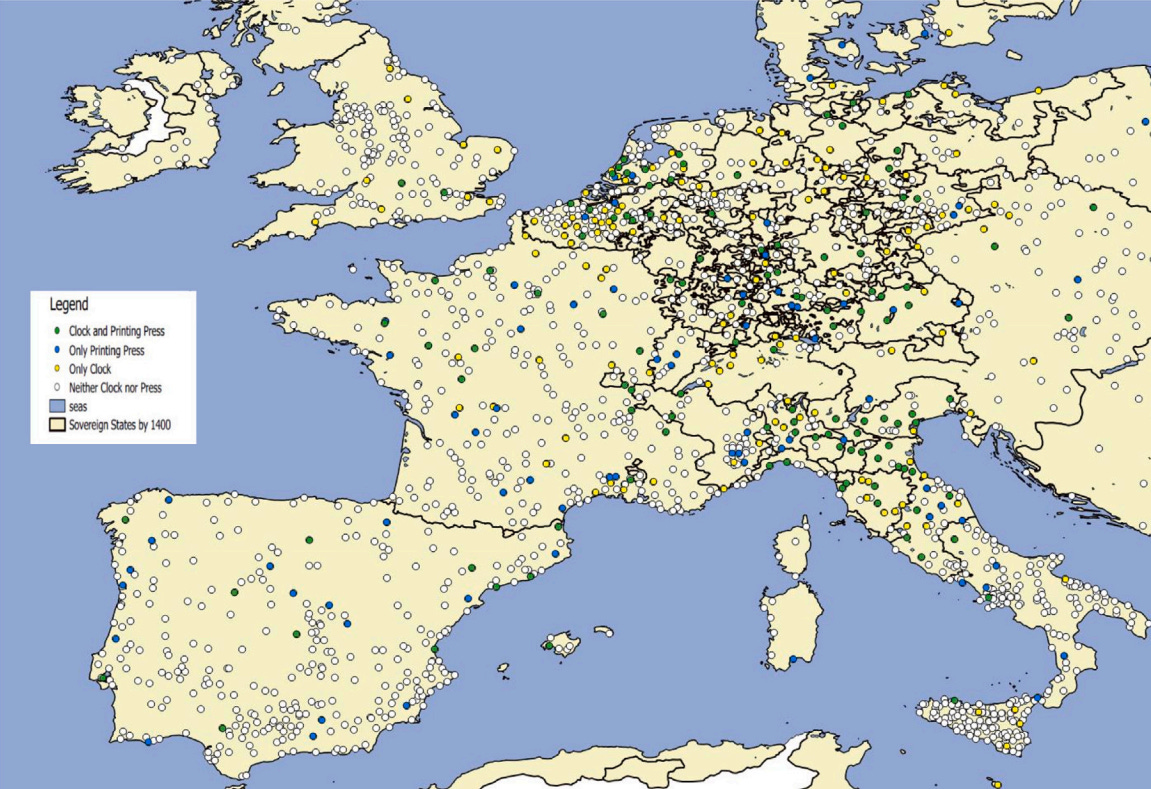
The cumulative adoption of the mechanical clock can be seen below. Mechanical clocks appear to have diffused most rapidly throughout Europe approximately between 1370 and 1400.
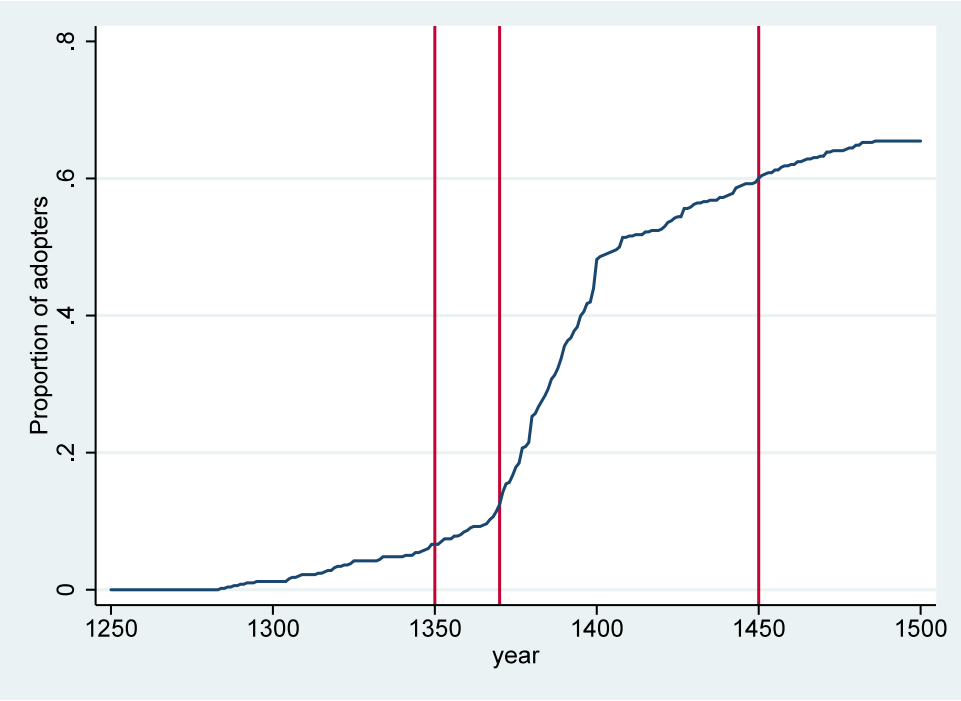
Easterly, Comin & Gong (2007) have assembled a dataset of national technology adoption in 1000 B.C., 0 A.D., and 1500 A.D., and from this developed measures of overall historical technological development of nations. For technological adoption by continent, they find that European nations on average had adopted most technology in 1500 A.D., with Asia taking the second spot (Table 4). Among advanced civilizations in 1500 A.D., West Europe had adopted the most technology and China second (Table 5).
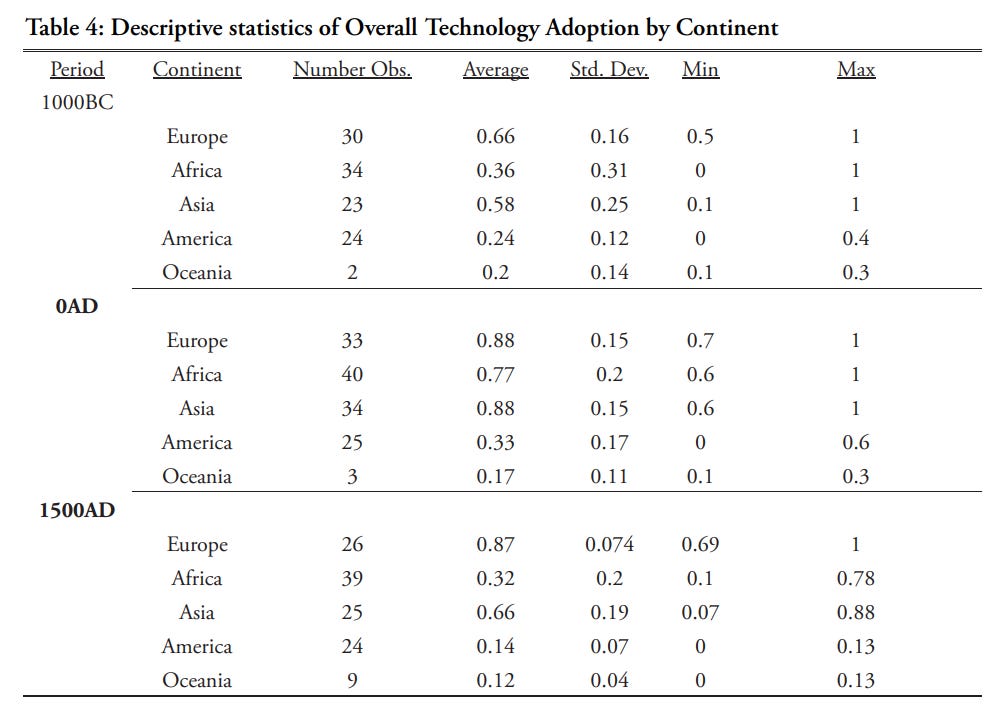
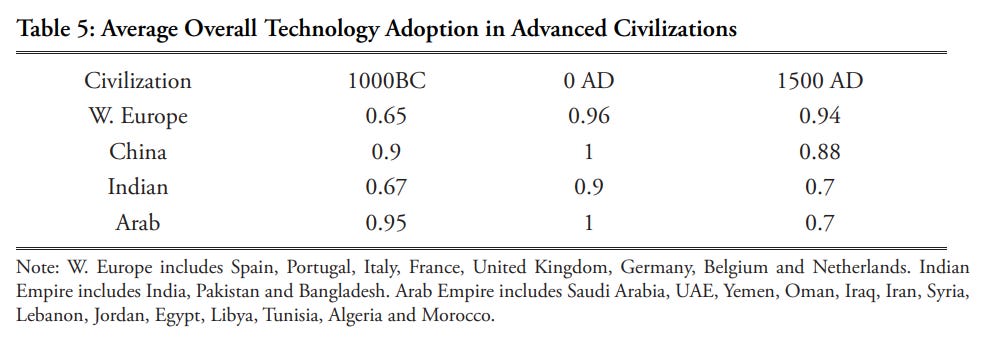
Grinin & Korotayev (2015) display the differing trends in scientific innovation between Europe and China (see below). A few interesting observations are worth noting. First, from 1000 onward, the number of innovations in Europe is increasing. The number of innovations in China stays relatively stable, there is no growth in innovation. So, while more innovations happen in China initially, this gap is shrinking in the centuries past 1000 AD. Second, a massive rise in innovation in Europe starts from around 1400 and beyond. This is not far after the inflection point I observe, where from around 1300, the rate of births of those who would become notable people of science starts increasing rapidly. These two facts together are consistent with my overall thesis: growth happening in Europe from 1000 and beyond, but enormous growth does not start until some period soon after 1300 AD. Third, the illustration is of total number of innovations, it is not on a per-capita basis. Further, it looks at the entirety of Europe, despite most innovation happening in West Europe. Thus, West Europe surpassed China in their per-capita rate of scientific and technological innovations at least by 1300 AD and undoubtedly greatly so by 1400 AD. Since this period, the disparity in innovation between Europe and China continued to grow in the following centuries (see also Grinin & Korotayev, 2015).
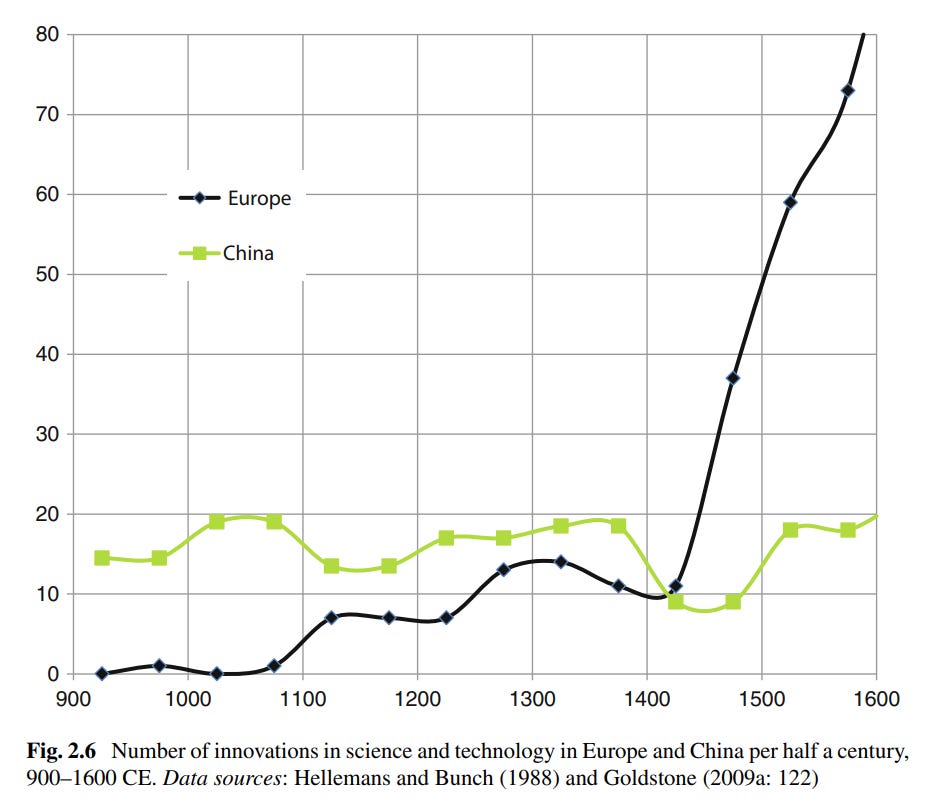
Urbanization
Goldewijk et al. (2010) estimate population densities and urbanization rates throughout history. In 1000, the estimated urbanization rate was highest in China and comparable between West Europe and India. But by 1500, the urbanization rate was highest in West Europe by a wide margin, with China and India having the second and third highest, respectively. Thus we see that West Europe developed ahead of China and India (and further ahead the rest of the world) somewhere between 1000 A.D. and 1500 A.D. in terms of urbanization rate.
Book production
Buringh & Van Zanden (2009) have documented a great rise in manuscript and book production that occurred in Europe during the Middle Ages and beyond. It should come as no surprise that book production rose and book prices fell greatly after Gutenberg’s printing press. However, it is worth noting that even in the preceding centuries, book production in Europe was growing at a high rate as illustrated below. Between the 6th and 14th century, prior to the printing press, the estimated per-capita rate of book production increased between 50 and 100-fold in West Europe (Buringh & Van Zanden, 2009; Table 3). After the printing press, it increased even more rapidly. Because of the logarithmic axis, what visibly looks roughly like a linear trend actually represents an exponential increase in per-capita book production over time. The authors note that universities, monasteries, and urbanization together statistically explain almost 60% of the variation in per capita book production during the Middle Ages.
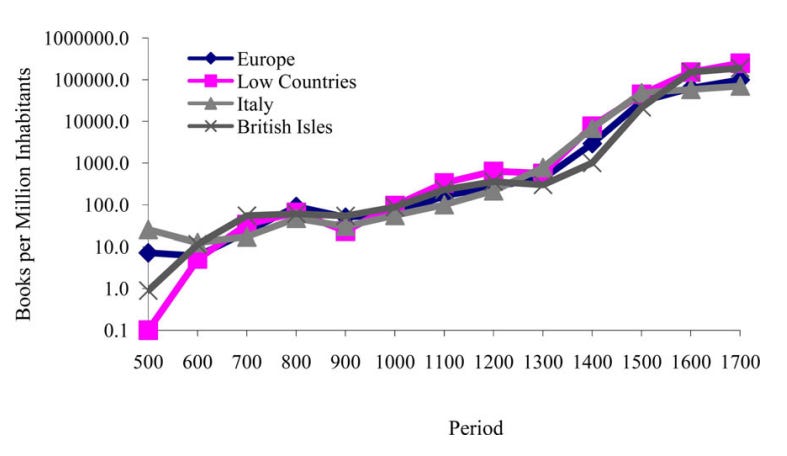
Literacy and numeracy
A variety of methods have been used to estimate levels of human capital in the far past. For example, by the proportion who can sign their name on a document or the proportion of people who can remember their age.8
In the past, literacy was primarily reserved for rich and powerful learned men. But following the adoption of the printing press, and probably starting even earlier, literacy and numeracy rates began to increase, particularly in West Europe. The literacy rate in West Europe went from roughly 1 in 10 in 1500 A.D. to 1 in 3 in 1800 A.D. (Buringh & Van Zanden, 2009). The figure below illustrates estimates of historical literacy rates in the UK since 1580.
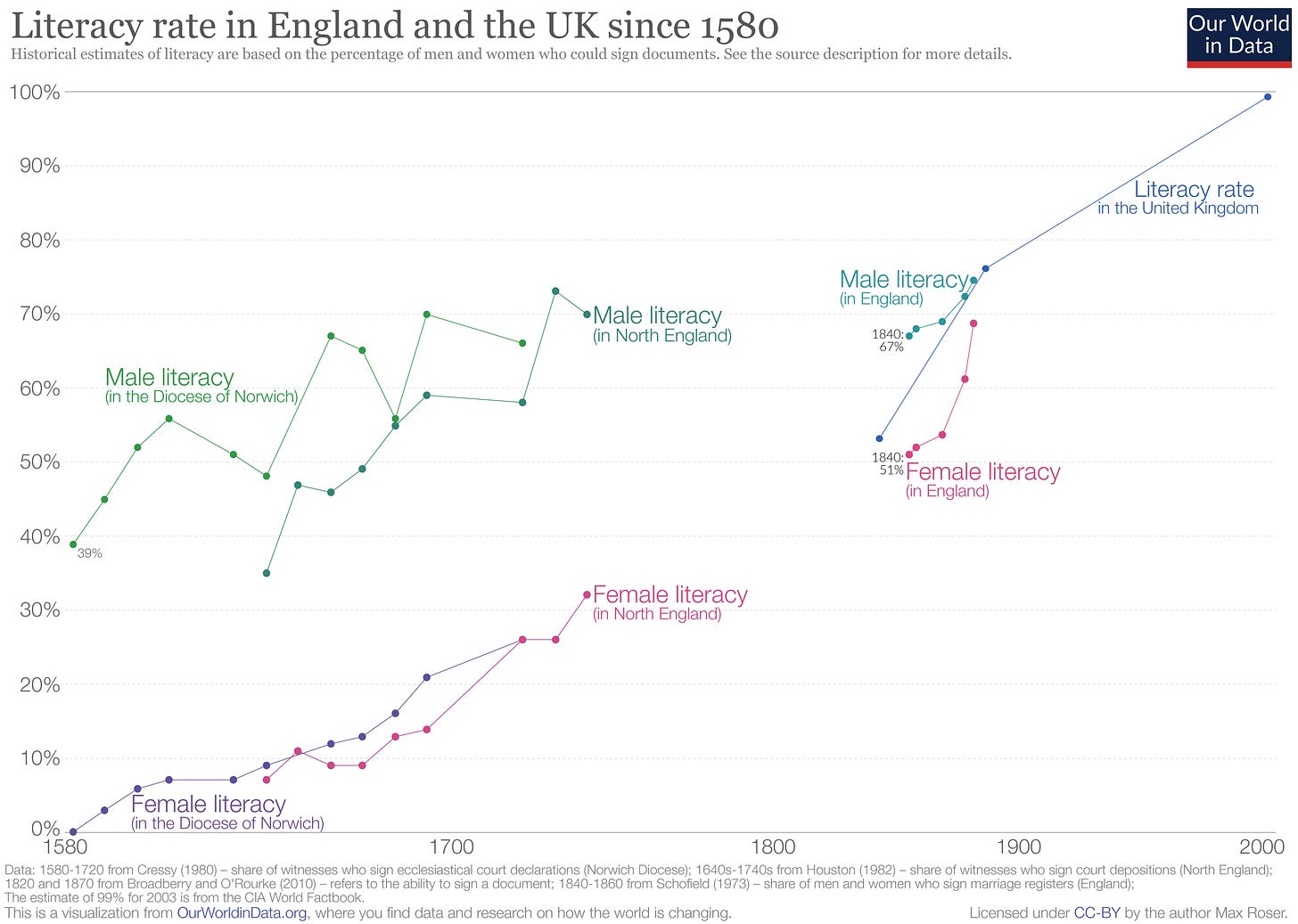
But literacy rates did not increase equally everywhere. Buringh & Van Zanden (2009) and Allen (2003) use different methodologies but both find that countries such as Spain and Poland experienced much smaller gains in literacy than places such as Great Britain or the Netherlands. Keywood & Baten (2021) also document a divergence in numeracy between West and East Europe in the Middle Ages, writing: “by 1400, a development path was firmly established that divided the east and the west of the continent.” Interestingly, they find that numeracy began increasing already from 600 AD on. In fact, literacy rates were probably also slowly rising long before the printing press in England (Pleijt, 2018). Thus the rise in basic human capital may have much earlier origins than the printing press.
It is worth noting how recent high literacy rates are in much of the world. Until the last 100 years, many (if not most) countries probably hadn’t reached literacy rates comparable to that of the 1600s in the Netherlands or Great Britain. As Our World in Data notes, the elderly living today in the Middle East and North Africa have very low literacy rates, whereas young people have dramatically higher literacy rates. A major transformation happening in just the last generation or two. Thus, like I observe in my analysis of rates of notable scientists, West Europe and the Islamic world also diverged greatly in literacy rates at least after the 1400s, perhaps especially on account of how differently they welcomed the printing press.
Violence
Another trend concurrent with the West’s ascension was not a rise but a fall in violence. At least starting from somewhere between 1400 and 1500, rates of interpersonal violence started falling dramatically, especially in Northwest Europe. Places such as England and Germany started falling early, whereas places like Italy and Scandinavia seem to have transitioned somewhat later. The overall drop in interpersonal violence in West Europe has been confirmed with multiple sources of data.9 Below is an illustration of the falling homicide rate in England, 1200–2000.
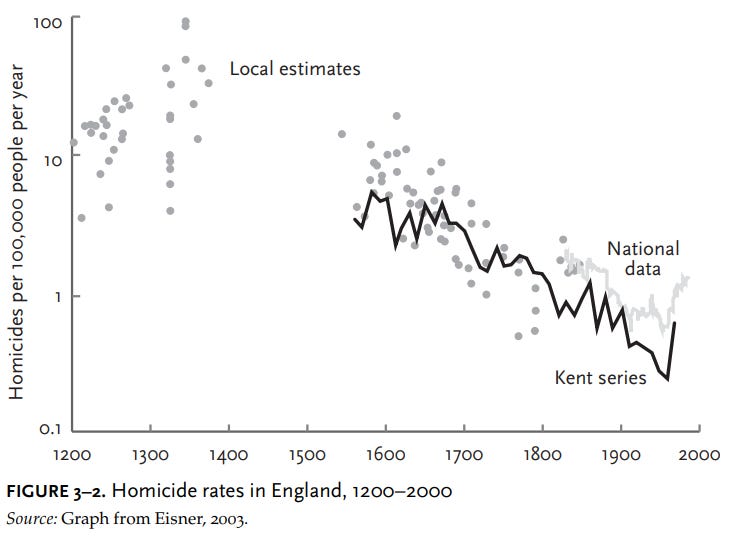
Economy
Lastly, we can consider the economy. In regards to documenting and measuring economic performance in the deep historical past, the economist Angus Maddison undoubtedly stood out as the pioneer. In Maddison (2005), he summarizes: “Western Europe’s economic ascension began about the year 1000, continued to 1820, and accelerated thereafter. Western Europe caught up with Chinese income levels in the fourteenth century.” The 14th century also matches the timing of the divergence I observe in per-capita rates of notable people of science. Another notable change in the economy was a great decline in interest rates in England and “echoed across the rest of Europe,” indicative of a shift in the willingness to forego immediate benefit for increasingly smaller future benefits (Clark, 2007).
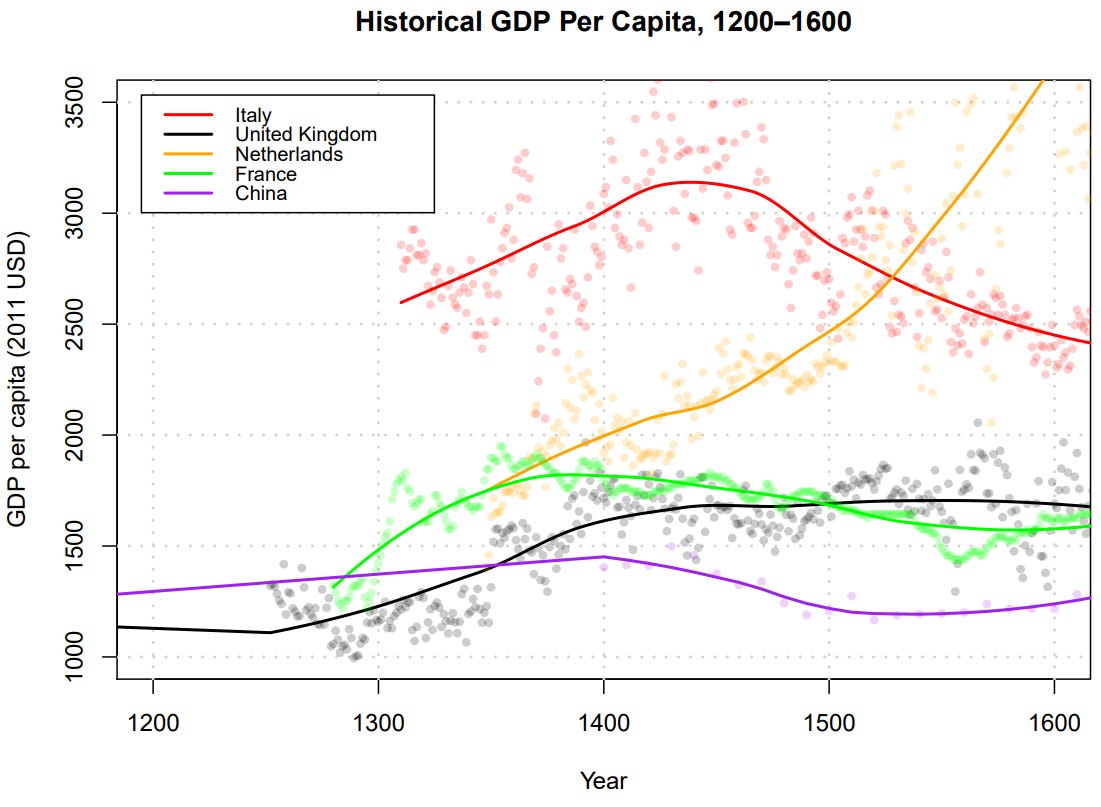
When West Europe overtook Chinese income levels, they became the richest major civilization in the world — India and the Middle East being both poorer than China on a per-capita basis.10 Above I have illustrated the per-capita GDP estimates of China and various West European countries for which good evidence is available. In 1300, Italy (or rather the Republic of Venice) was the richest nation by far. The United Kingdom, a late bloomer, still overtook China before 1400 AD. The Netherlands experienced the most explosive and persistent growth, and in the 16th century became the richest country — they have been described as “the first modern economy.” The North Sea area, including Britain and the Netherlands, would eventually be instrumental in the emergence of capitalism and the Industrial Revolution, resulting in unprecedented economic growth and creating the modern world as we know it.11
Discussion
West Europe experienced a major transformation between 1000 and 1500. Their incomes increased, they established institutions of higher learning across the continent, they became more urbanized, more technologically developed, produced vastly more books, literacy and numeracy increased, violence greatly decreased, and they produced many more notable scientists, mathematicians, philosophers, inventors, and engineers. In terms of overall development, West Europe had surpassed that of other big civilizations (China, India, and the Middle East) by 1500. Not only that, the rate of advancement was accelerating. The other major civilizations instead went into cultural stagnation.
The divergence I observe in the data of notable people of science, starting from approximately 1300 A.D., seems tightly connected with the so-called “Little divergence” (Pleijt & van Zanden, 2016), i.e., the “process [between 1300 and 1800] whereby the North Sea Area (the UK and the Low Countries) developed into the most prosperous and dynamic part of the Continent.” Starting in a similar period and in similar places (e.g., the Netherlands and the UK), I observe an especially great increase in per-capita rates of notable people of science.
As the rise of the West was already operating at great speeds prior to European colonialism, the often-suggested idea that the West’s ascent can be attributed to Europe’s colonialist history is untenable. Rather than colonialism or slavery being the cause of the rise of the West, the timeline is consistent with a commonsensical alternative idea: The colonization-development story gets the direction of causality backwards. It was the West’s relative developmental advantage that gave them the ability to colonize so successfully in the first place. Only wealthy societies could afford global exploration and subsidize colonies on a large scale. Oceangoing technology, improvements in vessels, shipbuilding, navigation tools, and in cartography, all together facilitated exploration and direct travel across the Atlantic. Advantages in military technology made conquest and colonization far easier, exemplified by “when Pizarro’s tiny army of Spaniards captured the Inca emperor Atahuallpa, absolute ruler of the largest, richest, most populous, and administratively and technologically most advanced Native American state” (Diamond, 1997).12
So what then explains the rise of the West? This analysis does not give us a specific answer, only that we must consider factors extant before 1500. Some scholars have forwarded theories about such distal causes. Jared Diamond famously takes a stab at such an explanation in “Guns, Germs and Steel”, focusing primarily on the importance geographical differences. The economic historian Gregory Clark in “A Farewell to Alms” instead forwards a “survival of the richest” model, where the richer outbred the poorer throughout the Middle Ages, slowly replacing the population with upper-middle class characteristics over the generations. Joseph Henrich argues for the importance of the “WEIRD” psychology which he claims is downstream from the church’s effect on family formation. Perhaps some entirely different explanation is right, or a mixture of everything discussed.
Whatever the true explanation is, the past continues to manifest in the present. There is a deep persistence of economic development (Spolaore & Wacziarg, 2013). Easterly et al. also find that historical adoption of technology in 1500 is strongly related to modern national wealth.13 An analogous investigation into historical rates of notable scientists and its correlates with later outcomes might also be interesting. A quick glance reveals that the countries with the highest per capita rates of physics Nobel prize winners are countries that also had high per capita rates of notable scientists centuries ago. Perhaps a topic worthy for another day.
For the sake of simplicity, in my analysis I define “West Europe” simply by considering an imaginary two-part European division with a line that cuts from the Adriatic sea (East of Italy) to the Baltic Sea. Italy, Switzerland, Germany, Denmark, Norway and all other European countries to their west are thus grouped as “West Europe,” whereas Slovenia, Austria, Czech Republic, Poland, Finland and countries to their east are not.
I have improved the methodology from my prior analysis where I use 1850 population estimates. Here I use population estimates at the point of birth of each notable person to calculate overall per capita rates, thus capturing the non-static nature of the population sizes.
China and India have very low production of notable people per capita in this period. They certainly have their share of notable people; the number is just low relative to the total population sizes. Consider that in 1500, China’s population was comparable to that of the entirety of Europe, and India’s population was even larger. They would each need to produce a total number of notable people that is higher than the entire continent of Europe to compete with West Europe’s per capita rate. Thus, with respect to this measure, medieval Europe’s only competitor is the Islamic world.
In the period 1000-1300, by this measure, these West European countries (Germany, UK, Switzerland, Belgium, Netherlands) produce on average 3.18 notable people of science per 1,000,000 people per 100 years. The Islamic countries (Syria, Iran, Iraq, Turkey) produce 2.88; China 0.19; and India 0.05. In the period before 1000, I find that the Middle East produces notable scientists at higher rates than West Europe.
The university was at least uniquely European in the definition typically used. China, the Middle East and India all had centers of higher learning in some shape or form, even if they differed in important ways from the university.
For the list of universities, I draw primarily from “A History of the University in Europe”, Chapter 2 “Patterns” written by Jacques Verger. See also this website. I manually sought after the approximate geographical coordinates. In a few cases, there is of course some amount of debate regarding whether they qualify as universities and regarding the year of establishment. This uncertainty is mostly true for the oldest examples. With that said, the great majority on the list are not in contention, and nothing consequential for this analysis happens with adjustments within the margins of this uncertainty.
Ibrahim Müteferrika was the first Muslim to run a printing press with movable Arabic type in 1727, centuries after the technology’s adoption in Europe. In his 1731 treatise Rational basis for the Politics of Nations he expresses the need for the Ottoman society to be reorganized along rational lines. He considers the question "Why do the Christian nations, which were so weak in the past compared with Muslim nations begin to dominate so many lands in modern times and even defeat the once victorious Ottoman armies?" To this he responds “Because they have laws and rules invented by reason.” He was also an important figure in the introduction of heliocentrism — the idea that the Earth orbits the Sun rather than vice versa — to Ottoman readers; an idea that was getting established earlier in Europe (not without its own difficulties) with the likes of Copernicus, Tycho Brahe, Galilei, and ultimately Newton.
A variety of methods have been used to estimate historical rates of basic human capital and skills, such as (a) estimates based on the per capita consumption of books (e.g., Buringh & Van Zanden, 2009), (b) estimates based on the share who could sign official documents (e.g., Allen, 2003), (c) estimates based on “age heaping”, i.e. the tendency for people to round their age when they are unsure about their exact age and have low numeracy skills (e.g., Keywood & Baten, 2021). See also the relevant Our World in Data post on Literacy.
The first source of data is simply records of people’s cause of death. While this is the most direct measure, it is also only available in societies with traditions of rigorous bookkeeping, and high-quality data only goes so far back. Another source of data is that of regicide, the killing of kings, with good data available due to the extent to which chroniclers independently document the lives of rulers throughout history. This source of data generally goes much longer back in history. Empirically, when both sources of data are available, the two tend to show similar trends, a reassuring fact that the latter method works as a decent proxy for measuring trends in overall rates of interpersonal violence. Yet another source of data comes from analyses of trends in human remains, specifically if skeletal fractures show evidence of violence. These sources of data are e.g. discussed in Baten & Steckel (2018) or Pinker’s “The Better Angels of Our Nature”. Additionally, Cummins (2017) also uses a creative method of estimating rates of battle deaths. The idea is that if a large number of nobility died on the same day, they were likely killed in a battle. With enough data one can then quantify trends in battle deaths. Cummins finds that battle deaths dramatically fell from 1500 to 1550, and that a general trend continued downward in the following centuries.
There is a common misconception that India was a rich civilization. Granted, it was a large economy with a large GDP, but that was entirely on account of its enormous population. Judging a country’s level of wealth from its GDP alone would lead to absurd conclusions. A hypothetical country where every single person was living in poverty could then be considered “rich”, given enough of those people. As for India, their fraction of the global GDP was probably lower than their fraction of the global population. In other words, the civilization was not rich on a per-capita basis, which is the more relevant quantity. Before the British colonization of India, the British GDP per-capita was already much higher than the GDP per-capita in India.
“The First Modern Economy” by Jan de Vries refers to the Netherlands. The book “Pioneers of Capitalism: The Netherlands 1000–1800” by Prak & Van Zanden documents the region’s economic history and describes its important role in the emergence of capitalism.
This understanding is not only consistent with the early periods of colonization, but also the later and more extensive ones. The 10 percent of Africa that was under formal European control in 1870 increased to almost 90 percent by 1914, a period known as the Scramble for Africa. This extremely rapid expansion was also facilitated by technological advancements of the Industrial Revolution.
Easterly et al. show that technological development in 1500 is strongly associated with present national economic development. In an associated blog post, Easterly writes “78 percent of the difference in income today between sub-Saharan Africa and Western Europe is explained by technology differences that already existed in 1500 AD – even BEFORE the slave trade and colonialism.”



Something I noticed in reading Charles Murray's 2003 book "Human Accomplishment" is that most of the rest of the Old World world went into cultural stagnation about the time that Europe took off in say the 1400s, well before European aggression could have been a sizable cause.
Japan was an exception and was moderately progressing, but still falling further behind up through 1853.
But much of the rest of the Old World -- Islam, India, China -- didn't do much to make themselves more advanced in the key years of, say, 1450 to 1750.
If I had to make a guess at a single leading reason, I'd probably say that the Islamic world didn't make use of the printing press. They weren't exactly against the printing press, but they weren't for it either.
Excellent analysis. I also like that you have debunked the myths that India was a rich civilization. Life in India has always been miserable until it became bearable during the British raj.
Also, Ibrahim Muteferrika was an ethnic European who was still drawn to the European rationalism despite converting to Islam.
What misses in your analysis is the role of the decimal system in supercharging European mathematics and establishing Western Europe as the pre-eminent scientific superpower by early 1600s. Stevin played a key role in developing the decimal system as explained here:
https://gnosophia.org/divine-ugsaggiga-sumerian-emegir-isopsephy-babylon-yahweh/